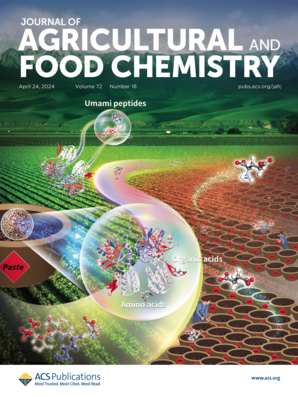Microbial Alliances: Unveiling the Effects of a Bacterial and Fungal Cross-Kingdom SynCom on Bacterial Dynamics, Rhizosphere Metabolites, and Soybean Resilience in Acidic Soils.
IF 6.2
1区 农林科学
Q1 AGRICULTURE, MULTIDISCIPLINARY
引用次数: 0
Abstract
Acidic soils, covering 40 to 50% of arable land, hinder productivity due to phosphorus limitation and aluminum toxicity. Using a synthetic community (SynCom) approach, we tested a native Rhizobium (Rh) and a non-native Ensifer fredii (Ef) strain, both combined with the mycorrhizal fungus Rhizophagus intraradices (Ri), on soybean growth in acidic soil. The native RhRi SynCom outperformed EfRi, significantly improving soybean growth, yield, and soil health. Metagenomics and metabolomics revealed that RhRi significantly enhanced beneficial microorganisms (AD3, Gemmataceae) and metabolites (putrescine, stearic acid), hence improving nutrient cycling, stress tolerance, and membrane integrity. RhRi also enhanced soil enzyme activity (urease, phosphatases), which resulted in an increase in nitrogen and phosphorus availability and a decrease in rhizosphere toxicity. These alterations enhanced plant resilience, soil structure, and microbial diversity. RhRi activated metabolic pathways (amino acids, lipids, ABC transporters, and secondary metabolites) that are involved in nutrient acquisition and stress response. Conversely, EfRi provided minimal advantages, emphasizing the significance of native microbial compatibility. Our findings show that native SynComs boost crop resilience and production in acidic soils through synergistic microbial interactions and metabolic reprogramming, thereby offering a sustainable agricultural strategy in harsh environments.微生物联盟:揭示细菌和真菌跨界SynCom对酸性土壤中细菌动态、根际代谢物和大豆恢复力的影响。
酸性土壤,覆盖40 - 50%的可耕地,阻碍生产力由于磷的限制和铝的毒性。采用合成群落(SynCom)方法,研究了原生根瘤菌(Rh)和非原生芽胞杆菌(Ef)菌株与菌根真菌Rhizophagus intraradices (Ri)联合对酸性土壤中大豆生长的影响。原生RhRi SynCom优于EfRi,显著改善大豆生长、产量和土壤健康。宏基因组学和代谢组学显示,RhRi显著增强了有益微生物(AD3, Gemmataceae)和代谢物(腐胺,硬脂酸),从而改善了营养循环,耐受性和膜完整性。RhRi还能提高土壤酶活性(脲酶、磷酸酶),增加氮磷有效性,降低根际毒性。这些变化增强了植物的恢复力、土壤结构和微生物多样性。RhRi激活了参与营养获取和应激反应的代谢途径(氨基酸、脂质、ABC转运蛋白和次级代谢物)。相反,EfRi提供了最小的优势,强调了原生微生物相容性的重要性。我们的研究结果表明,原生SynComs通过协同微生物相互作用和代谢重编程提高了酸性土壤中作物的抗逆性和产量,从而在恶劣环境中提供了一种可持续的农业策略。
本文章由计算机程序翻译,如有差异,请以英文原文为准。
求助全文
约1分钟内获得全文
求助全文
来源期刊
CiteScore
9.90
自引率
8.20%
发文量
1375
审稿时长
2.3 months
期刊介绍:
The Journal of Agricultural and Food Chemistry publishes high-quality, cutting edge original research representing complete studies and research advances dealing with the chemistry and biochemistry of agriculture and food. The Journal also encourages papers with chemistry and/or biochemistry as a major component combined with biological/sensory/nutritional/toxicological evaluation related to agriculture and/or food.

 求助内容:
求助内容: 应助结果提醒方式:
应助结果提醒方式:


